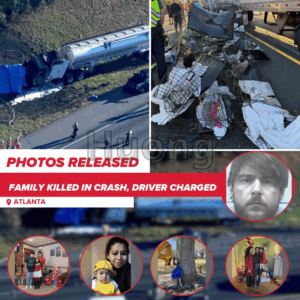In the heart of New York City’s relentless morning rush, where commuters jostle like waves in a stormy sea, a tiny bundle of life appeared like a ghost from a forgotten dream. On October 20, 2025, at precisely 9:04 a.m., an unidentified woman slipped through the crowded corridors of the 34th Street-Penn Station subway stop, cradling a newborn girl wrapped in a simple blanket. She placed the infant on the southbound platform for the No. 1 train and vanished into the throng, leaving behind not just a child, but a whirlwind of questions that have gripped the city. The New York Police Department has released haunting surveillance footage of the woman, capturing her fleeting figure in a red headscarf and pink pants, her face obscured but her actions etched in infamy. As the baby, dubbed the “Miracle on 34th Street” by transit officials, fights for her future in a hospital crib, one burning mystery lingers: Was this a desperate act of love or the prelude to a darker secret buried in the shadows of the city that never sleeps?
Penn Station, that labyrinthine beast of steel and stone, is no stranger to human drama. Every day, it swallows and spits out over 600,000 souls—tourists wide-eyed with wonder, executives barking into phones, performers strumming for spare change. But on this crisp autumn Monday, amid the cacophony of screeching brakes and muffled announcements, something profoundly human pierced the chaos. The woman, estimated to be in her 40s, entered the station’s bowels wearing a multicolored top that some speculate could be a hospital gown, glasses perched on her nose, and a scarf that did little to hide her purposeful stride. Surveillance cameras caught her descending the stairs to the platform, the blanket clutched tightly against her chest. At 9:04 a.m., in a spot tucked near the edge of the southbound 1 train’s waiting area, she gently set the bundle down. The baby, still with her umbilical cord attached—a stark sign of her raw newness to the world—stirred faintly beneath the fabric.
It wasn’t until about 9:30 a.m. that fortune intervened. An anonymous commuter, perhaps sensing something amiss amid the blur of trench coats and backpacks, spotted the unattended package on the cold concrete steps leading to the 1, 2, and 3 trains. A quick call to 911 summoned the NYPD and FDNY like avengers in blue. “She’s alert, conscious, and breathing on her own,” a first responder later recounted, the relief in his voice cutting through the sterile hum of Bellevue Hospital, where the infant was rushed for evaluation. Doctors confirmed she was a full-term newborn, weighing in at around 6 pounds, with no immediate signs of injury or neglect beyond the obvious trauma of separation. By evening, she was stable, hooked to monitors in the neonatal unit, her tiny fists clenching as if grasping for answers her young life couldn’t yet comprehend.

Demetrius Crichlow, president of New York City Transit, couldn’t contain his awe at a press conference that afternoon. “I’m calling it the ‘Miracle on 34th Street’—a little earlier than the movie, but no less magical,” he said, drawing chuckles from a crowd of reporters still buzzing from the morning’s frenzy. The moniker stuck, evoking the holiday classic filmed just blocks away, where faith and whimsy triumph over cynicism. Yet beneath the feel-good label lies a stark reality: This miracle teeters on the edge of tragedy. The footage, grainy but unmistakable, shows the woman glancing around before fleeing on foot, weaving through the platform’s human tide toward the exits. NYPD detectives from Midtown South Precinct are combing every frame, enhancing images for clues—a tattoo glimpsed on her wrist? A limp in her step? The public has been urged to come forward, with tip lines lighting up like Times Square neon.
What drives someone to such an act in a city famed for its safety nets? New York’s Abandoned Infant Protection Act, often called the Safe Haven Law, offers a lifeline: Parents can surrender a newborn up to 30 days old at hospitals, police stations, or firehouses without fear of prosecution, provided the child is handed directly to a responsible adult. Enacted in 2000 after a spate of heartbreaking discoveries in trash bins and alleys, the law has facilitated over 1,500 anonymous handoffs, saving lives shrouded in desperation. “It’s a quiet revolution in child welfare,” one advocate notes, emphasizing how it destigmatizes surrender. But Penn Station? That’s no designated drop-off. It’s a public vortex, where a blanket-clad infant risks hypothermia from the drafty tunnels or worse—trampling by oblivious feet. Experts whisper of postpartum psychosis, financial ruin, or the shadows of human trafficking, though no evidence points there yet. The woman’s attire fuels speculation: If that top is indeed a hospital gown, did she give birth mere hours earlier, perhaps in a nearby ER, and bolt in panic?
The baby’s plight has ignited a firestorm of emotion across the five boroughs and beyond. Social media exploded with #MiracleOn34th, a hashtag blending prayers and pleas. “Who could leave such perfection in the cold?” one viral post lamented, attached to a sketch artist’s rendering of the infant’s cherubic face—eyes like polished chestnuts, a tuft of dark hair peeking from under the blanket. Adoption agencies are already circling, with foster parents lining up for a chance to claim her. “She’s a fighter from the start,” a social worker shared, describing how the girl latched onto a bottle with surprising vigor during her first feeding. Child Protective Services has taken guardianship, vowing a swift path to a loving home. Yet for every heart emoji, there’s a thread of outrage: Why not a firehouse door ajar on a quiet street? Why a platform teeming with straphangers at peak hour?
This incident isn’t isolated; it’s a grim echo in New York’s tapestry of urban survival. Just last year, a toddler was found wandering the F train in Queens, her mother later revealed to be battling severe addiction. In 2023, an infant’s cries led cops to a dumpster behind a Bronx bodega, the case unraveling into a tale of teen pregnancy and familial shame. Each story peels back layers of the city’s underbelly—immigrant mothers without papers fearing deportation, single parents crushed by skyrocketing rents (Manhattan’s average one-bedroom now tops $4,500 monthly), or the silent epidemic of mental health crises post-pandemic. The subway, with its 472 stations and 24/7 pulse, has become an unwitting confessional, absorbing secrets in the roar of the third rail. “Penn Station is where dreams collide—and sometimes shatter,” a veteran MTA worker reflected, his eyes distant as he recounted decades of “near-misses.”
As detectives chase leads—the woman last seen heading north toward Herald Square—the focus sharpens on prevention. Mayor’s Office to End Domestic and Gender-Based Violence has ramped up PSAs in multiple languages, flashing on digital billboards: “You are not alone. Surrender safely.” Hotlines hum with calls from those on the brink, a silver lining to the sorrow. Faith leaders from St. Patrick’s Cathedral to the Islamic Cultural Center are opening dialogues, reminding congregants that grace extends to the fallen. And in hospital rooms across the city, obstetricians are weaving Safe Haven info into discharge packets, turning moments of birth into beacons of hope.
For the little girl at the center of it all, the road ahead gleams with possibility. Named temporarily “Hope Penn” by her caregivers—a nod to the station’s gritty romance—she’s already captivating her medical team. “She locks eyes like she knows her story’s just beginning,” a nurse confides. Will her mother return, compelled by maternal pull? Or will a new family etch her into their legacy, far from the platform’s echoes? The footage loops in precinct screens, a silent plea for closure. In a metropolis that devours stories daily, this one clings like the blanket’s frayed edge—tender, tenacious, and utterly human. As October’s chill deepens, New York holds its breath, waiting for the next frame in this unfolding drama. Who was she? Why here? And in the answer, perhaps, redemption for all.


